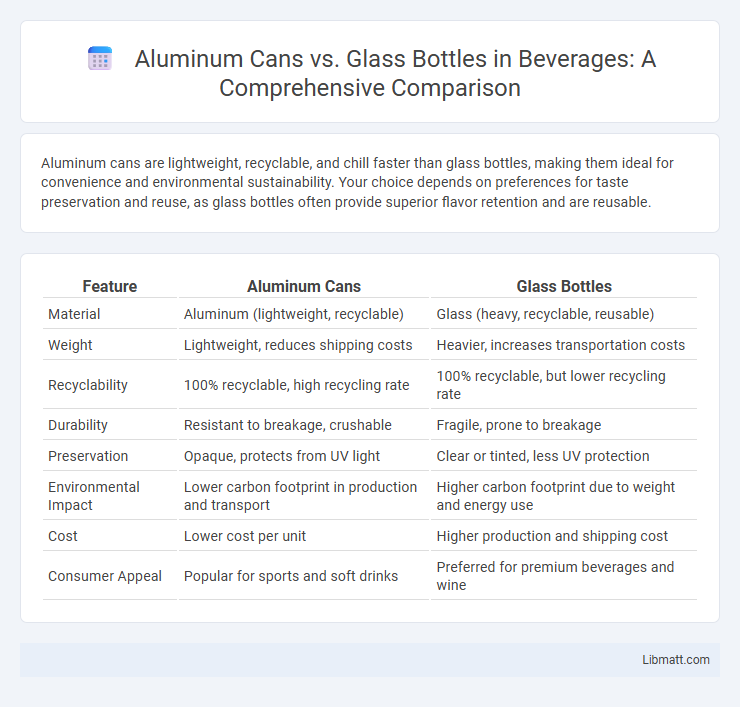Aluminum cans are lightweight, recyclable, and chill faster than glass bottles, making them ideal for convenience and environmental sustainability. Your choice depends on preferences for taste preservation and reuse, as glass bottles often provide superior flavor retention and are reusable.
Table of Comparison
| Feature | Aluminum Cans | Glass Bottles |
|---|---|---|
| Material | Aluminum (lightweight, recyclable) | Glass (heavy, recyclable, reusable) |
| Weight | Lightweight, reduces shipping costs | Heavier, increases transportation costs |
| Recyclability | 100% recyclable, high recycling rate | 100% recyclable, but lower recycling rate |
| Durability | Resistant to breakage, crushable | Fragile, prone to breakage |
| Preservation | Opaque, protects from UV light | Clear or tinted, less UV protection |
| Environmental Impact | Lower carbon footprint in production and transport | Higher carbon footprint due to weight and energy use |
| Cost | Lower cost per unit | Higher production and shipping cost |
| Consumer Appeal | Popular for sports and soft drinks | Preferred for premium beverages and wine |
Environmental Impact of Aluminum Cans vs Glass Bottles
Aluminum cans have a lower environmental footprint due to their high recyclability rate, requiring only 5% of the energy used to produce new aluminum compared to raw production. Glass bottles, while reusable multiple times, have a heavier weight, leading to increased carbon emissions during transportation. Recycling glass is energy-intensive, and lower recycling rates contribute to more waste in landfills compared to aluminum cans.
Production Process and Resource Consumption
Aluminum cans require significantly less energy to produce compared to glass bottles, with aluminum recycling saving up to 95% of the energy needed for primary production. The production of glass bottles demands higher temperatures, consuming more fuel and water resources, with a carbon footprint nearly three times that of aluminum cans. Resource consumption for aluminum is more sustainable due to higher recyclability rates and lower raw material extraction impacts.
Recycling Efficiency and Rates
Aluminum cans boast a high recycling efficiency, with about 75% of all produced aluminum ever recycled due to their ability to be recycled indefinitely without quality loss. Glass bottles also have a strong recycling rate, often around 33%, but the process is more energy-intensive and can degrade quality over multiple cycles. You can significantly reduce environmental impact by choosing aluminum cans, as they require less energy to recycle and contribute to a circular economy more effectively.
Transportation and Carbon Footprint
Aluminum cans are significantly lighter than glass bottles, reducing transportation fuel consumption and lowering carbon emissions during distribution. The high recyclability rate of aluminum further decreases the overall carbon footprint compared to glass, which is heavier and more fragile, leading to increased breakage and higher transportation costs. Efficient logistics and recycling infrastructure contribute to aluminum's advantage in minimizing environmental impact in beverage packaging.
Durability and Breakage Concerns
Aluminum cans offer superior durability compared to glass bottles, as they are highly resistant to dents, cracks, and breakage during transportation and handling. Glass bottles, while providing a premium feel, are fragile and prone to shattering, posing safety risks and potential product loss. Choosing aluminum cans for Your beverage packaging minimizes breakage concerns and ensures safer, more reliable storage and delivery.
Beverage Quality and Preservation
Glass bottles provide superior beverage quality and preservation by creating an airtight, non-reactive barrier that prevents oxidation and flavor alteration. Aluminum cans are lined to protect beverages but may still impart metallic tastes over time, especially if exposed to heat. Both containers protect from light, but glass offers better long-term preservation, particularly for craft beers and premium beverages sensitive to flavor changes.
Cost Comparison for Manufacturers
Aluminum cans generally present lower production and transportation costs for manufacturers due to their lightweight nature and efficient recycling processes, reducing raw material expenses. Glass bottles, while offering premium appeal, incur higher manufacturing costs because of energy-intensive production and greater shipping weight. The cost differential significantly impacts large-scale beverage producers prioritizing operational efficiency and sustainability goals.
Consumer Preferences and Perceptions
Consumer preferences between aluminum cans and glass bottles often hinge on convenience, sustainability, and product freshness. Aluminum cans are favored for their lightweight, portability, and superior recyclability, while glass bottles are perceived as premium, offering better taste preservation and a more environmentally friendly image. Your choice may depend on lifestyle priorities, such as ease of transport versus a commitment to perceived natural quality.
Innovations in Sustainable Packaging
Innovations in sustainable packaging include the development of lightweight aluminum cans with higher recycled content, significantly reducing energy use and greenhouse gas emissions compared to traditional glass bottles. Advanced coating technologies improve aluminum can recyclability while extending product shelf life, contributing to a circular economy. Your choice between aluminum cans and glass bottles supports ongoing efforts to minimize environmental impact through enhanced material efficiency and innovative recycling processes.
Future Trends in Beverage Containers
Emerging trends in beverage containers highlight increased adoption of aluminum cans due to their lightweight, recyclability, and faster cooling properties compared to glass bottles. Innovations in sustainable packaging emphasize eco-friendly coatings on aluminum to improve taste preservation and reduce environmental impact. Market forecasts predict a continued shift towards aluminum, driven by consumer demand for convenience and sustainability, while glass bottles retain niche appeal for premium and artisanal beverages.
Aluminum cans vs glass bottles Infographic

 libmatt.com
libmatt.com